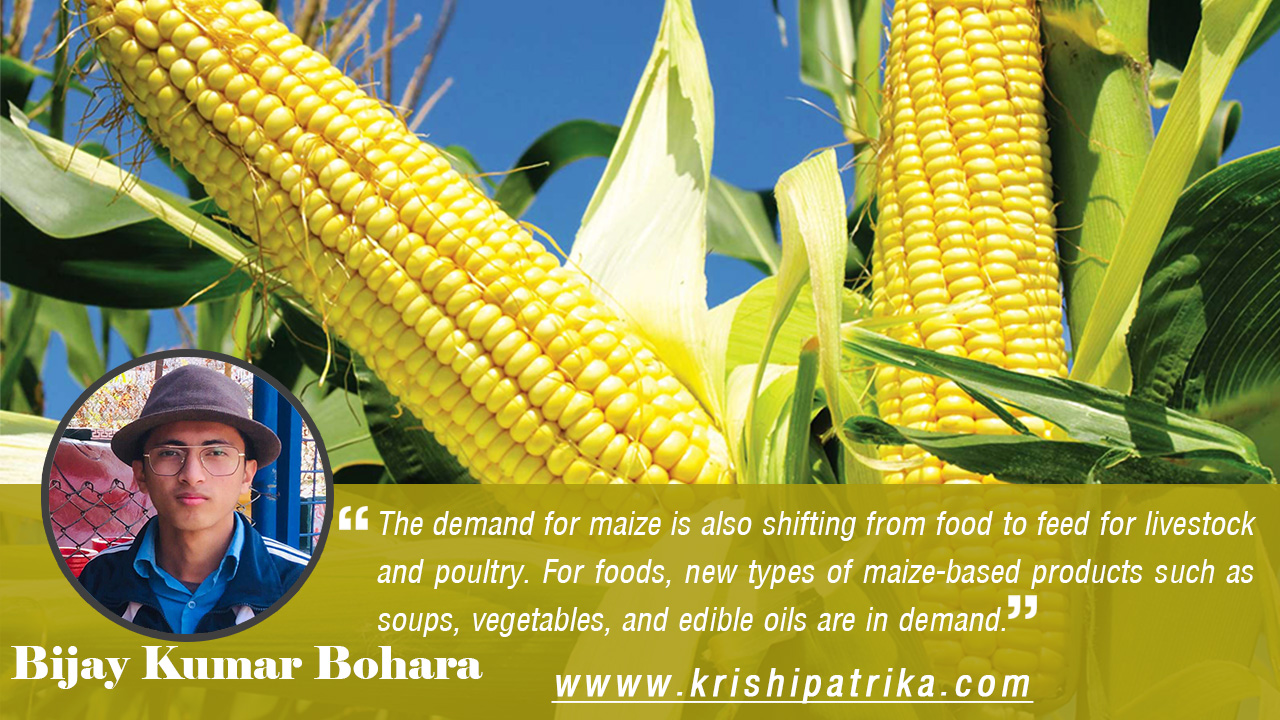
Maize (Zea mays L.) is the main crop after Rice in Nepal in terms of area and production (MOAD, 2015). Ranum et al. (2014) reported that 98 g/person/day was the per capita maize consumption in Nepal, which was the highest in South Asia. It is a principal food crop of the hilly farmers and source of animal feed for different feed industries in the Terai region of Nepal (KC et al., 2015). In the hills of Nepal, more than 86% of maize production has been used for human consumption, and 80% of maize production in the Terai is used for poultry and animal feed (Gurung et al., 2011). The farm-level yield of maize (2.45 t/ha) is not satisfactory as compared to the attainable yield (5.7 t/ha) in Nepal (MOAD, 2014; KC et al., 2015). The demand for maize is also shifting from food to feed for livestock and poultry. For foods, new types of maize-based products such as soups, vegetables, and edible oils are in demand. Under such circumstances, the import substitution can only be done by increasing the productivity of maize with the available shrunken land. Winter maize under the rice-wheat system has been emerging as a new intervention and it can be an option to increase maize production in Nepal. The area under winter maize in eastern and central Terai is increasing year after year.

Procedure for maize cultivation
Selection of land
- Fertile, light loamy, and sloppy (or non-water-logged) soil is good for maize cultivation.
Crop rotation for reducing disease and pest
- For the controlling of disease and pest, the same family crop should not be continuously cultivated every year in the same plot, and crop rotation should be adopted every 3 years.
- If farmers cultivate maize every year in the same plot, virus & other soil-borne diseases will be increased gradually.
- The crop rotation can be adopted as given below:
First of all, farmers should divide their fields into 3 plots.
In the first year, cultivate the maize in 1st plot, cultivate potato in 2nd plot & if possible cultivate legume in 3rd plot.
In the 2nd year, continue the same procedure following the same time & season but rotate the crops like maize will be in 2nd plot, potato in 3rd plot & legume or vegetable will be in 1st plot.
In the third year, do the same as before by rotating the crop.
This way, every three years, there will be changes in the crops in farmers’ fields, which will help to control and eradicate the disease & pest in the crop production field.
Germination test of commercial seed from Agro-vet
- If possible, it would be better to use certified and disease-free seed to prevent seed-borne disease, otherwise there is a risk of low production.
- Among the seeds received from the market, the warranty tag of the seed bag should be checked whether that is the right variety or not. After that, the germination test of the seed should be done.
- To identify the germination capacity of seeds, the following ways can be followed:
Keep sand/ soil in a flexible container or carton box, and remove stones from sand/ soil.
Take 200 seeds randomly from the seed bag.
Show the 100 seeds in one carton box making 10 rows with 10 seeds in each row, and repeat the same process for another 100 seeds in another carton box, to simultaneously getting a more exact germination rate. During sowing, seed to seed distance should be 2.5 cm. to 3 cm and the depth should be double the seed size and should provide daily irrigation.
Count seedlings for up to 7 days to know the vigor of the seed.
If the germination rate of the seed was found to be more than 85%, these seeds can be used as seeds. But, if it is less than 85% germination, either other quality seeds have to be procured or sow the seed more.
Land preparation and sowing of maize
(A) Field sanitation before cultivation
In case residues of earlier crops remain in the field, the larva of the pest & disease of the previous crops stay alive in the soil, and attack the new crops as well. Therefore, the field should be cleaned after harvesting.
(B) Application of FYM (Farm yard manure)
- Around 50-60 bamboo baskets (DOKO) of well-fermented FYM per Ropani of land should be applied during the land preparation or first plowing (1-2 months earlier of cultivation).
- Use of unfermented FYM (farmyard manure) can increase pests such as white grubs, cutworms, and other worms.
- In case, heaps of FYM are put in the field for a long time, the nutrients in the GYM will be lost and insects may lay eggs in the heaps also. So, it should be better to spread the manure and plow the field immediately.
(C)First plowing
- 1-2 months before planting, during Dec-Jan, the first plowing should be done.
- Ploughing should be done after putting the well-fermented FYM (50-60 DOKO / Ropani) as organic fertilizer on the field.
- Plough the field two times, which will make the soil loose, and make it easy for aeration and root growth. The first time, plough the field 5-8 cm deep, and the second time 10-15 cm deep should be done.
- In case, there is a big size of soil clods present in the field after first plowing, the breaking of those clods should be done manually with the help of spade or other equipment before those clouds become hard.
(D)Second plowing and sowing of maize
- The field should be ploughed a second time just before seed sowing in line with the application of a basal dose of chemical fertilizers. Apply 2.6 kg of Urea, 3 kg of DAP, 2.5 kg of Potash per Ropani as a basal dose of fertilizer.
- Line sowing has an advantage over broadcasting as it requires less seed, facilitates easy weed control.
(E)Methods of sowing seeds
- Foundation seeds will be soaked for 1 night in water, and dry slightly in the shade before sowing.
- The field needs to have adequate moisture (when the condition of the surface of the field soil becomes somewhat brownish, and when we take the soil on palm and tighten it with fingers, it will slowly break after releasing the fingers) during sowing time for using water-soaked seeds.
- 2-3 maize seeds should be sown in each spot 3-5 cm deep in rows.
- Seeds should be sown in the spacing of 20-24 cm from seed to seed and 60-68 cm from line to line.
Conclusion
The maize production in the mid-hills of Nepal focusing on its utilization pattern was studied to know the current production and utilization scenarios. Study shows about 50% of the maize areas were covered by hybrid maize. There was no practice of contract maize production. A major part of the maize production has been used in farmers’ animal feeding in the study area which is in increasing trend. The results revealed that 60%, 25%, and 3% of the grain were used for animal feed, food, and seed respectively. Whereas the remaining amount of the maize (12%) was sold to different buyers. Similarly, the feed industry has tremendous demand for maize. Out of the total maize that was used in feed production, 87% of the maize was imported from India each year by feed industries. This shows a big scope to increase domestic production and supply of maize. Analysis shows a negative correlation between the scale of feed production and the use of domestic maize. This was due to the unavailability of the required quantity of domestic maize in time. The result shows 13% and 8.5% per year increasing demand for poultry feed and animal feed, respectively over the last five years. Demand for a meat-based diet has been increasing in Nepal. Moreover, it is reported that consumers are consuming a higher quantity of micronutrient and protein-rich food items compared to the last decades in Nepal. In such a situation, it is necessary to increase the domestic maize production focusing on feed through prioritizing hybrid maize development and its scaling up.









